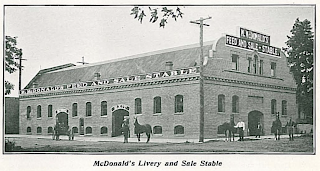If you are curious about what went on in Walla Walla during the Roaring Twenties, watch the brief video I made featuring stories from Up to the Times magazine and photos provided by Joe Drazan from his Bygone Walla Walla collection. CDs of Joe's many photos and ads can be purchased at Walla Walla Public Library and proceeds from their sale benefit the library.
About Me

- Susan Monahan
- I have lived in Walla Walla for four years and I plan on living out my days here. I have been writing about local buildings for three years now and am so grateful to have so many fascinating places to research.
Tuesday, August 6, 2013
Walla Walla in the 1920s
If you are curious about what went on in Walla Walla during the Roaring Twenties, watch the brief video I made featuring stories from Up to the Times magazine and photos provided by Joe Drazan from his Bygone Walla Walla collection. CDs of Joe's many photos and ads can be purchased at Walla Walla Public Library and proceeds from their sale benefit the library.
If you are curious about what went on in Walla Walla during the Roaring Twenties, watch the brief video I made featuring stories from Up to the Times magazine and photos provided by Joe Drazan from his Bygone Walla Walla collection. CDs of Joe's many photos and ads can be purchased at Walla Walla Public Library and proceeds from their sale benefit the library.
Thursday, August 1, 2013
Walla Walla's Livery Stables
 |
| Small's Opera House and Livery Stable 1890 |
Livery is defined as the care and boarding of horses for a fee, and a horse owner could choose different boarding "plans." One could pay just to have a horse housed in a livery stable but have responsibility for feeding and grooming it and even cleaning out its stall. Or an owner could subscribe to a more expensive plan where the livery stable did everything, in some cases even exercising or training a horse. A vital service was provided by these stables to those who did not own a horse. Liveries had coaches available for hire and even provided delivery and moving services. If one needed to move a piece of furniture, visit a relative in the country or just take a Sunday ride, it all started at the nearby livery.
In the 1880s one could board a horse downstairs at Mr. Small's livery on Main street and then go upstairs to take in a lecture or musical performance. The Small Livery Stables and Opera House is gone now, but its ornate appearance is represented accurately in the mural in Heritage park. An imposing brick livery stable we can still see at 4th and Poplar was built in 1905 by Mordo MacDonald and housed 75 horses on three floors. Fires were common in livery stables; the Union Bulletin reports an especially big blaze in 1915 when nine horses died. Brick liveries were more likely to survive a fire and more likely to be repurposed rather than torn down.
 |
| The Former McBride's Livery Stable |
 |
| A McBride-built Carriage 1907 |
In the early 1900s the livery business was starting to fade. The stables were threatened by the increasing number of automobiles and some even banned "horseless carriages" from their property. The McBrides gradually reduced their livery business and started to sell off their hack carriages. Charles McBride kept with the times by operating an auto taxi service out of his former livery business. It was probably with reluctance that Mr. McBride and other Walla Walla stable owners gave up their fine horses and stately carriages. It is fortunate that some of their buildings still stand and remind us that there was a time when we relied on livery stables to keep Walla Walla moving.
Late-breaking Livery News!!
 |
| McDonald's Livery in Process of Restoration |
Since
I wrote my post about McBride's livery, a building at Fourth and
Poplar has been going through an exciting refurbishing. Yellow paint
has been stripped, mellow brick restored and the original signs on
the front and side revealed to show us all that Mordo McDonald's
Stable filled the huge building. Joe Drazan provides a great photo of
the interior. Up to The Times
featured many ads and a shot of the exterior from 1908.
 |
| Interior of McDonald's Livery Stable 1910 |
 |
| McDonald's Livery Stable 1908 |
A 1910 pamphlet described Mordo McDonald's business: "One of the best known livery and sale stables is McDonald's, corner Fourth and Poplar Streets. Here you will find a large brick barn of modern type and equipped with every convenience.It comprises three floors and will accommodate 75 horses."
It
is such a privilege to watch this handsome building through its stages
of restoration.
Saturday, June 15, 2013
In 1920 a building was erected on the corner of Main and Spokane the likes of which Walla Walla had never seen. Mr. A. M. Jensen, an established local businessman, hired the Beezer Brothers from Seattle to build a department store that would make a statement.The two stories of A. M. Jensen's store were clad in intricate sculptural forms made of white glazed terra cotta. Surrounded by stately brick offices with tall curved windows that were typical of Walla Walla's downtown in 1920, this new building must have seemed quite the architectural anomaly. Up to the Times magazine, February 1920, described it as "a handsome building, metropolitan in its appointments." Mr. Jensen's ad described the residents of the Walla Walla Valley as "progressive people" who "demand that the store keeper do his share and provide merchandizing service in keeping with the present day and age."
 The architects, Louis and Michael Beezer, were twins and devout Catholics. They had commissions all over Washington state, but designed mostly churches and banks, including Walla Walla's First National (now Banner) and Baker-Boyer Bank. The Beezers were based in Seattle but also had an office locally, in the Drumheller Building. The brothers' experience with designing churches led to their acquaintance with Charles J. Connick, a master stained glass designer, and they invited him to design windows for the store. Mr. Connick knew Mr. Jensen liked to describe his establishment as " the modern daylight store" and created windows of leaded glass to illuminate the interior. The combination of Connick's windows and the roof-to-pavement white glazed terra cotta facade made A. M. Jensen's bright and beautiful inside and out.
The architects, Louis and Michael Beezer, were twins and devout Catholics. They had commissions all over Washington state, but designed mostly churches and banks, including Walla Walla's First National (now Banner) and Baker-Boyer Bank. The Beezers were based in Seattle but also had an office locally, in the Drumheller Building. The brothers' experience with designing churches led to their acquaintance with Charles J. Connick, a master stained glass designer, and they invited him to design windows for the store. Mr. Connick knew Mr. Jensen liked to describe his establishment as " the modern daylight store" and created windows of leaded glass to illuminate the interior. The combination of Connick's windows and the roof-to-pavement white glazed terra cotta facade made A. M. Jensen's bright and beautiful inside and out.
Mr. Jensen had a department store on Alder for years before he opened this new store on Main in 1920. He knew he could not rely on his remarkable building alone to attract customers; Jensen's offered a wide variety of clothing, appliances, furniture, radios and toys. The 90 employees were not only sales staff; some worked in the "Marinello Beauty Salon" and there were cooks and waitpersons staffing Jensen's Tea Room. A 1920 ad for the Tea Room said Saturday evening dinner was available for $1, and entertainment was provided by "Cowan's orchestra, conducted by Miss Etta Holt."
Mr. Jensen died in 1948 at age 80; he had been in the department store business for 36 years. The Allied Department Stores bought his store and in 1951 changed its name to Bon Marché and began "improvements." It is not clear when the terra cotta on the street level was bricked over, when the elegant wrought iron awning over the front entrance was removed, or what happened to Charles Connick's leaded glass windows. A 1993 parade photo with the Bon Marché in the background shows an awning running around the building as it does today, brick covering the first floor terracotta and the upstairs windows covered. The Bon operated their store until 2005 when Federated Department stores rebranded the store as Macy's.
Walla Walla residents are grateful to still have a department store downtown, and Macy's inside still has a classic department store "feel." The architectural drawing provided by Joe Drazan shows us what A.M. Jensen's looked like in 1920. Standing across Main street and looking above the awning, the remaining sculptural white glazed terra cotta facade can still be seen on the second story, and using our imagination we can visualize it covering the first story too. Our mind's eye can uncover the upstairs windows and enlarge those downstairs. With some effort, 93 years after it was built, we can still see A. M. Jensen's one-of-a-kind "modern daylight store."
Subscribe to:
Posts (Atom)





